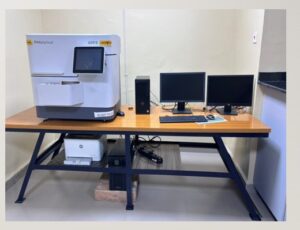NBRRI Diffractometer (X-Ray Diffraction – XRD): Structural Analysis of Construction Materials

The
NBRRI Diffractometer (X-Ray Diffraction – XRD) is a specialized instrument used by the
Nigerian Building and Road Research Institute (NBRRI) to analyze the crystalline structure of materials. This advanced analytical tool is crucial for understanding the mineralogical composition of construction materials, such as cement, soil, aggregates, and other geotechnical samples. X-ray diffraction (XRD) provides insight into the arrangement of atoms within a crystal structure, allowing researchers to identify materials’ phase composition, purity, and stability, which are critical factors in construction quality and durability.
Function
The primary function of the NBRRI Diffractometer (XRD) is:
- To analyze the crystalline structure and phase composition of materials, providing valuable information on their mineral content, chemical stability, and physical properties.
The XRD method works by measuring the diffraction patterns created when X-rays interact with the atomic planes within a crystal. This unique “fingerprint” pattern allows for the identification and quantification of various crystalline phases within a material, which is essential for ensuring quality and performance in construction applications.
Applications
The NBRRI Diffractometer (XRD) is extensively used in applications that require detailed structural analysis of materials:
- Cement and Concrete Analysis:
XRD is instrumental in analyzing the composition and quality of cement, detecting phases like calcium silicates, aluminates, and other compounds that contribute to strength and durability. It helps optimize cement formulations to meet specific construction needs.
- Soil Mineralogy and Geotechnical Studies:
XRD helps in identifying the mineral composition of soils, which affects properties like swelling, shrinkage, and load-bearing capacity. Understanding soil mineralogy is essential for evaluating its suitability for different construction projects.
- Aggregate and Stone Testing:
Aggregates and stones used in construction are tested with XRD to ensure they contain the right mineral phases for stability and longevity. XRD can detect deleterious minerals that may lead to premature degradation, aiding in the selection of quality materials.
- Research and Development in Material Science:
In research, XRD is used to develop new materials and study the effects of additives on structural properties. Researchers use it to understand how certain crystalline phases enhance or weaken material performance, supporting innovation in construction materials.
How It Works
The NBRRI Diffractometer (XRD) works by directing X-rays at a material sample and recording the resulting diffraction pattern:
- Sample Preparation:
The sample is typically ground into a fine powder to ensure an even distribution of crystalline planes, placed on a sample holder, and inserted into the diffractometer.
- X-Ray Beam Interaction:
The diffractometer generates a beam of X-rays, which is directed at the sample. As X-rays hit the sample’s atomic planes, they are diffracted, creating a unique pattern based on the crystal structure.
- Recording Diffraction Patterns:
The diffracted X-rays are detected, and their angles and intensities are recorded. Each crystalline phase produces a distinct pattern, providing a “fingerprint” for identification.
- Data Analysis:
Specialized software analyzes the diffraction pattern to identify and quantify the crystalline phases present, offering insight into the material’s structural composition.
This precise method allows for the detection and quantification of even minor phases, making XRD an essential tool for ensuring that construction materials meet the necessary standards.
Benefits of the NBRRI Diffractometer (XRD)
- Ensures Material Quality and Performance: By identifying and quantifying crystalline phases, XRD helps confirm that materials will exhibit the desired structural characteristics, crucial for building longevity and safety.
- Supports Geotechnical Stability and Soil Analysis: XRD provides detailed insights into soil mineralogy, helping engineers make informed decisions about site suitability and soil treatment options.
- Facilitates Innovation in Material Development: XRD is widely used in research to develop and improve construction materials, enabling the creation of durable and sustainable infrastructure.
In summary, the
NBRRI Diffractometer (X-Ray Diffraction – XRD) is an invaluable tool in material analysis for the Nigerian Building and Road Research Institute. By providing a deep understanding of crystalline structures, it supports the quality assurance, research, and development of high-performance construction materials, contributing to safer and more reliable infrastructure.
 The NBRRI Diffractometer (X-Ray Diffraction – XRD) is a specialized instrument used by the Nigerian Building and Road Research Institute (NBRRI) to analyze the crystalline structure of materials. This advanced analytical tool is crucial for understanding the mineralogical composition of construction materials, such as cement, soil, aggregates, and other geotechnical samples. X-ray diffraction (XRD) provides insight into the arrangement of atoms within a crystal structure, allowing researchers to identify materials’ phase composition, purity, and stability, which are critical factors in construction quality and durability.
The NBRRI Diffractometer (X-Ray Diffraction – XRD) is a specialized instrument used by the Nigerian Building and Road Research Institute (NBRRI) to analyze the crystalline structure of materials. This advanced analytical tool is crucial for understanding the mineralogical composition of construction materials, such as cement, soil, aggregates, and other geotechnical samples. X-ray diffraction (XRD) provides insight into the arrangement of atoms within a crystal structure, allowing researchers to identify materials’ phase composition, purity, and stability, which are critical factors in construction quality and durability.
